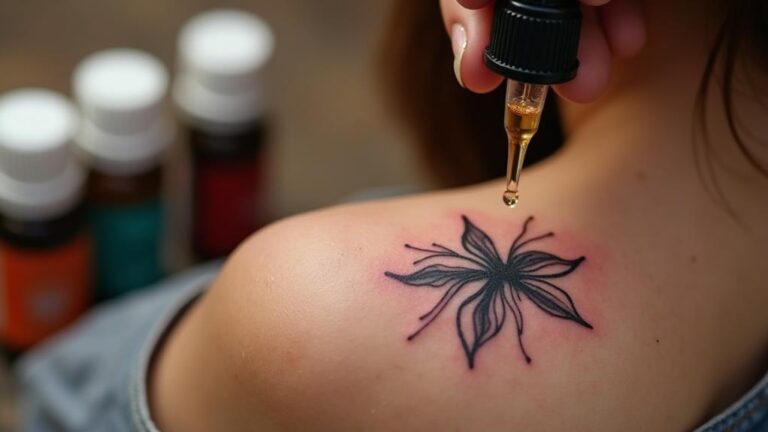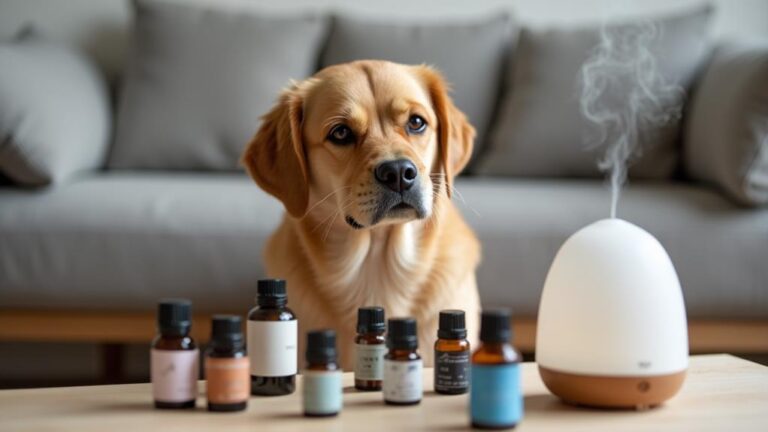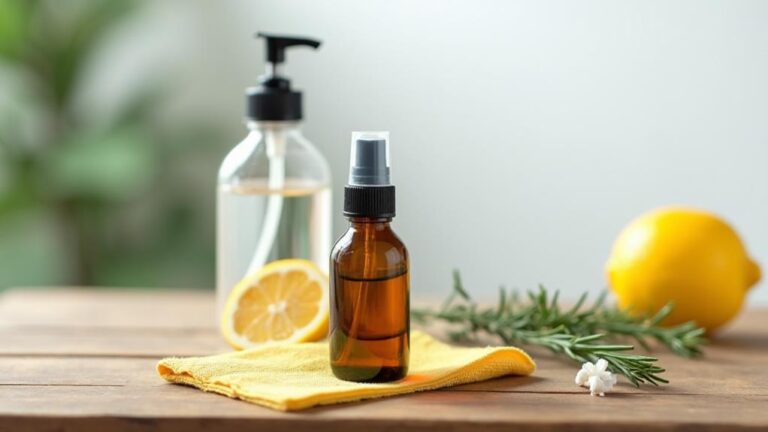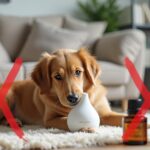Stepping into the world of doTERRA essential oils can be like discovering a treasure trove – the possibilities are endless, but you need the right key to reveal them safely. As a beginner, it's vital to prioritize quality and safety when selecting and using essential oils. With so many options available, it can be overwhelming to determine where to start. You're probably wondering what sets high-quality oils apart and how to guarantee you're using them correctly. To get the most out of your essential oils while minimizing risks, it's imperative to understand the basics of safe usage, and that's exactly where we're headed next.
Key Takeaways
- Research doTERRA's quality control measures and third-party certifications to ensure oil purity and safety.
- Always read and follow label instructions carefully, as different oils have unique usage guidelines.
- Dilute essential oils in a carrier oil before applying to the skin to avoid adverse reactions and guarantee therapeutic benefits.
- Start with low concentrations (about 1%) and consult with a healthcare professional or certified aromatherapist before using essential oils.
- Perform a patch test before using a new essential oil to check for skin sensitivity and potential allergic reactions.
Choosing the Right Essential Oils
As you step into the world of essential oils, it's crucial to cut through the noise and select the right oils for your needs.
With numerous brands and varieties available, choosing the right essential oils can be intimidating.
To make informed decisions, you'll want to explore essential oil profiles.
These profiles provide detailed information on an oil's chemical composition, therapeutic properties, and safety guidelines.
When evaluating essential oil profiles, consider the oil's botanical name, extraction method, and concentration of key compounds.
This information will help you determine the oil's potential benefits and risks.
Brand comparisons can also be helpful in selecting the right oils.
Research reputable brands like doTERRA, and compare their products based on factors such as quality, purity, and pricing.
Understanding Essential Oil Quality
| Quality Aspect | Description | Importance |
|---|---|---|
| Oil Sourcing | Origin and cultivation of the plant | Directly impacts oil's chemical composition and efficacy |
| Quality Control | Testing and evaluation of oil's quality | Guarantees oil meets safety and efficacy standards |
| Botanical Identity | Verification of plant species | Prevents adulteration and ensures correct usage |
| Purity Testing | Analysis of oil's chemical composition | Detects contaminants and adulterants |
When evaluating essential oil quality, look for companies that provide transparent information about their oil sourcing and quality control measures. Reputable companies will conduct rigorous testing to certify their oils meet high standards. You can also check for third-party certifications, such as ISO or GC/MS testing, to verify the oil's quality. By understanding essential oil quality, you can make informed decisions and guarantee you're using safe and effective oils.
Safe Essential Oil Usage
When diving into the world of essential oils, it's crucial to prioritize safe usage to maximize their benefits and minimize potential risks.
As a beginner, it's imperative to have a solid understanding of essential education and oil awareness to safeguard you're using your oils effectively and safely.
To achieve this, consider the following key principles:
- Always read and follow the label instructions carefully, as different oils have unique usage guidelines.
- Keep essential oils out of reach of children and pets to avoid accidental ingestion.
- Perform a patch test before using a new essential oil to check for skin sensitivity.
- Start with small amounts and gradually increase as needed to avoid overwhelming your senses.
- Consult with a healthcare professional or certified aromatherapist before using essential oils if you have a medical condition or are pregnant/breastfeeding.
Essential Oil Dilution Ratios
Your understanding of safe essential oil usage now provides a solid foundation for exploring one of the most vital aspects of using these oils effectively: proper dilution. Essential oil dilution is vital to avoid adverse reactions and guarantee the therapeutic benefits of the oils. To achieve proper dilution, you'll need to understand essential oil percentages and how to calculate them.
| Essential Oil Percentage | Carrier Oil Percentage | Total Volume |
|---|---|---|
| 1-2% | 98-99% | 1 teaspoon (5ml) |
| 2-3% | 97-98% | 1 teaspoon (5ml) |
| 3-5% | 95-97% | 1 teaspoon (5ml) |
| 5% | 95% | 1 tablespoon (15ml) |
| 1% | 99% | 2 tablespoons (30ml) |
When calculating essential oil percentages, remember that 1% is equivalent to 5-7 drops of essential oil per teaspoon (5ml) of carrier oil. Always use high-quality carrier oils that complement the therapeutic properties of your essential oils. By mastering essential oil dilution ratios, you'll be able to harness the full potential of your doTERRA essential oils while minimizing the risk of adverse reactions.
Potential Skin Irritations
Properly diluted essential oils can substantially reduce the risk of potential skin irritations, but it's essential to acknowledge that some individuals may still experience adverse reactions.
When you apply essential oils topically, you may encounter skin reactions, which can manifest in different forms. Understanding the various irritation types is pivotal for effective prevention and management.
If you experience any of the following skin reactions after using essential oils, discontinue use and consult a healthcare professional:
- *Allergic contact dermatitis*: a delayed hypersensitivity reaction, resulting in redness, itching, swelling, and blistering.
- *Irritant contact dermatitis*: a non-specific, immediate reaction, causing redness, itching, and burning sensations.
- *Phototoxicity*: an adverse reaction triggered by UV radiation, leading to skin discoloration, blistering, and burning.
- *Sensitization*: an increased sensitivity to specific essential oils, resulting in more severe reactions with repeated exposure.
- *Skin irritation_: a non-specific reaction, characterized by redness, itching, and mild discomfort.
Using Essential Oils on Children
Using essential oils on children requires careful consideration, as their sensitive skin and developing immune systems make them more susceptible to adverse reactions. When using essential oils on children, it's vital to prioritize child safety and use kid-friendly oils.
| Essential Oil | Age Group | Dilution Ratio |
|---|---|---|
| Lavender | 6 months+ | 1-2% |
| Frankincense | 6 years+ | 0.5-1% |
| Geranium | 6 years+ | 0.5-1% |
| Tea Tree | 10 years+ | 1-2% |
| Bergamot | 10 years+ | 0.5-1% |
When selecting essential oils for children, choose oils that are gentle and non-irritating. Always dilute essential oils in a carrier oil, such as coconut or jojoba oil, before applying them to a child's skin. The dilution ratio will vary depending on the child's age and the specific essential oil being used. Always consult with a healthcare professional before using essential oils on children, especially if they have a medical condition or are taking medication. Remember to store essential oils out of reach of children to safeguard their safety.
Essential Oil Allergy Precautions
To minimize the risk of adverse reactions, it's vital to take precautions when introducing new essential oils into your routine.
Essential oil allergy precautions are vital to guarantee safe usage, especially if you have a history of oil sensitivities.
When using doTERRA essential oils, you must be aware that some oils can cause skin irritation or allergic reactions, even if you've used them before.
To mitigate this risk, you should perform a patch test on a small area of your skin before using a new oil.
- Perform a patch test on a small area of your skin (like behind your ear or on your wrist) before using a new oil.
- Dilute the essential oil in a carrier oil (like coconut or jojoba oil) before applying it to the skin.
- Start with a small amount of oil and gradually increase the concentration as needed.
- Be cautious when using essential oils that are known to be skin irritants, such as cinnamon or peppermint oil.
- If you experience any skin irritation or allergic reactions, discontinue use and consult a healthcare professional.
Safe Storage and Handling
To guarantee the quality and safety of your doTERRA essential oils, you'll need to store them in a suitable environment.
You should store your essential oils in a cool, dry place, away from direct sunlight and heat sources, to prevent degradation and spoilage.
Proper labeling of your essential oils is also vital, as it allows you to identify the oil, its concentration, and any safety precautions you should take when using it.
Storage Environment
Proper storage of doTERRA essential oils is crucial to maintaining their potency, quality, and safety.
To keep your essential oils fresh and effective, you need to store them in the right environment. This means controlling the climate and keeping them in dark areas.
When it comes to climate control, you want to store your essential oils in a room with a consistent temperature between 60°F and 80°F (15°C and 27°C).
Avoid storing them near heating vents, radiators, or direct sunlight, as this can cause the oil to degrade or become contaminated.
Store essential oils in a cool, dry place away from direct sunlight.
Keep them away from heat sources, such as ovens, heaters, or fireplaces.
Use a storage case or box to protect the oils from light and dust.
Avoid storing essential oils in humid or damp areas, such as basements or attics.
Keep them away from children and pets to prevent accidental ingestion.
Essential Oil Labeling
Every doTERRA essential oil bottle is labeled with critical information that you should be aware of to guarantee safe storage and handling.
When reading the label, pay attention to the label claims, which provide information on the oil's intended use and any cautions or warnings associated with it.
Additionally, review the ingredient disclosure, which lists the botanical name of the plant from which the oil is derived, as well as any potential allergens or additives.
Familiarize yourself with the International Nomenclature of Cosmetic Ingredients (INCI) name, which is the standardized name used to identify the plant species.
Be aware that doTERRA essential oil labels also include information on the recommended usage and any necessary safety precautions.
Always follow the label instructions and take note of any potential interactions or contraindications.
Moreover, doTERRA labels include a batch number and expiration date, ensuring that you can track the oil's quality and freshness.
When storing your essential oils, make sure to keep the labels visible and easily accessible for quick reference.
Essential Oil Pregnancy Precautions
When using doTERRA essential oils during pregnancy, you must take certain precautions to safeguard a safe and healthy experience.
In the first trimester, it's vital to exercise extreme caution due to the fetus's rapid development and increased sensitivity to external substances.
You'll want to familiarize yourself with general safety guidelines and first trimester precautions to minimize potential risks and make informed decisions about essential oil use during this critical period.
First Trimester Precautions
During the first trimester of pregnancy, you'll want to exercise caution when using essential oils, as this period is critical for fetal development.
Although essential oils can be beneficial, some may pose a risk to the developing fetus. It's crucial to use them judiciously and under the guidance of a healthcare professional.
Some essential oils may exacerbate morning sickness, while others may help alleviate symptoms.
To guarantee safe use, consider the following precautions:
- Avoid using essential oils that stimulate the uterus, such as clary sage and pennyroyal, as they may cause contractions.
- Use gentle, calming oils like lavender and ylang-ylang, which may help with morning sickness and promote relaxation.
- Dilute essential oils with a carrier oil, as undiluted oils can be too potent for the skin.
- Limit your use of essential oils to small amounts and short periods.
- Avoid ingesting essential oils, as this can be particularly hazardous during the first trimester.
Remember to always consult with a healthcare professional before using essential oils during pregnancy, especially during the first trimester.
General Safety Guidelines
To guarantee safe use of essential oils throughout your pregnancy, you'll want to establish a routine of checking the specific safety guidelines for each oil.
This will verify you're using them correctly and minimizing potential risks. As you navigate oil education, it's vital to familiarize yourself with essential precautions to take during pregnancy.
When using essential oils, always dilute them in a carrier oil before applying to your skin, as undiluted oils can cause irritation.
Start with a low concentration (about 1%) and gradually increase as needed. Be cautious of oils that can stimulate the uterus or cause hormonal changes, such as clary sage and pennyroyal.
Instead, opt for gentle oils like lavender and ylang-ylang, which promote relaxation and calmness.
Consult with your healthcare provider or a certified aromatherapist before using essential oils, especially if you have a high-risk pregnancy or pre-existing medical conditions.
Always follow the recommended usage guidelines and be mindful of the quality of the oils you're using. By taking these essential precautions and prioritizing oil education, you'll be able to safely enjoy the benefits of essential oils throughout your pregnancy.
Frequently Asked Questions
Can Essential Oils Be Used on Pets or Animals?
When using essential oils on pets, you must exercise caution, as they can be toxic. Typically, pet owners aren't aware that many oils haven't undergone animal testing, emphasizing the need for research and consultation.
Are Doterra Essential Oils Suitable for Cooking?
When using doterra essential oils for cooking, you're adding potent flavor enhancers. Verify culinary safety by following proper dilution ratios, using food-grade oils, and referencing doterra guidelines to avoid adverse reactions or toxic interactions.
Can I Use Expired Doterra Essential Oils Safely?
You're wondering if expired oils are still magical, but sadly, no. Essential oils have a limited shelf life, and using expired ones may compromise oil potency, so it's best to discard them for safety.
Are Essential Oils Safe Around Open Flames or Sparks?
You handle essential oils carefully near open flames or sparks, as they can be highly flammable and ignite quickly, posing significant flame risks. Take spark precautions by keeping oils away from heat sources and open flames.
Can I Use Doterra Essential Oils in My CPAP Machine?
You shouldn't use Doterra essential oils in your CPAP machine, as it can cause harm. Instead, consider oil diffusers alternatives or consult the manufacturer. Pet safety concerns also apply, so keep oils out of reach.
Conclusion
By following these guidelines, you'll confidently navigate the world of doTERRA essential oils. According to the National Association for Holistic Aromatherapy, over 75% of households in the US use essential oils for health and wellness, highlighting their growing popularity. To guarantee your safety and that of your loved ones, prioritize quality, proper usage, and storage. Stay informed, and you'll access the full benefits of doTERRA essential oils while minimizing potential risks.














